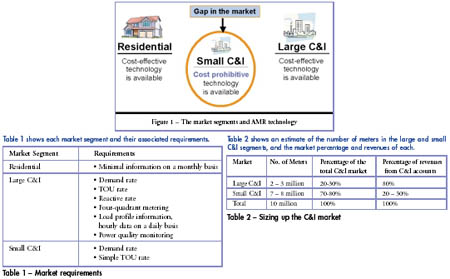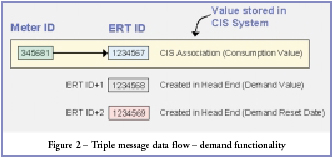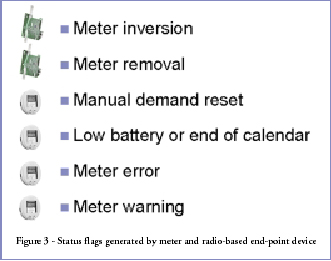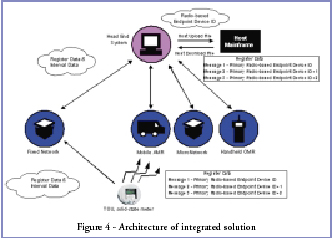In today’s market, cost-effective automated meter reading (AMR) technologies exist for two major segments—residential and large commercial and industrial (C&I). A noticeable gap exists however for the small C&I segment consisting of convenience stores, service stations, fast food franchises, and other small commercial facilities. Although AMR solutions exist for the small C&I segment, implementing the technology has been cost-prohibitive for the utility. Until now, AMR solutions for the residential segment have not had the capability to handle the demand and time-of-use (TOU) requirements for the small C&I segment.
This article addresses the newly emerged, small C&I segment and the challenges and opportunities facing it. These challenges exist in the emerging deregulated market, as well as for utilities operating in the more traditional energy market. Currently, the market is demanding an increase in the quantity and quality of meter data as well as an increase in the speed at which that data is collected and shared. So how will a utility meet these demands for their small C&I accounts? Are AMR technologies really practical and economical for this market segment?
This article explores why the small C&I segment has been underserved by AMR technologies and how utilities can implement cost-effective AMR solutions for this segment. Learn how existing technologies have been integrated to offer a new radio-based AMR solution for the small C&I segment. Technical challenges encountered during development, such as having the meter calendar perform self-reads and handling multiple, radio-based endpoint device serial numbers have been addressed and overcome. A costeffective AMR solution for the small C&I segment is now attainable for a utility. An integrated technology solution exists that offers functionality for time-of-use metering, self-initiated demand resets, an advanced meter calendar, new functionality for walk-by, drive-by and fixed network reading systems, and retrieval of data directly from solid-state meter registers. And, all this is possible without making any code modifications to the utility’s existing CIS system.
The Evolving AMR Market
AMR technologies have shown a lot of promise but have not achieved total market saturation as expected. Five years ago, when AMR was less prevalent, the market was divided into two very unique segments – residential and C&I. The residential segment required very minimal information on a monthly basis, whereas the C&I segment required more functionality such as demand, TOU, reactive, and four-quadrant metering. Meter information for the C&I segment was needed for load profiling, often requiring hourly data to be collected daily. The C&I segment also wanted information on power quality monitoring. As the market evolved, three distinct segments emerged rather than two. The third segment, shown as the gap in the market in Figure 1, represents the small C&I segment currently underserved by cost-effective AMR technologies.
Currently, utilities have employed very large, mobile, AMR routes, some encompassing over a million meters. Within these saturated areas are small C&I accounts that are geographically disparate in the service territory. In most cases, utilities must still send meter readers to manually read these small C&I accounts, even though these accounts fall directly on an existing AMR reading route for a drive-by or walk-by system. It is not cost-effective for utilities to reach these accounts.
Taking into consideration the remoteness factor and the distance between each meter, a single meter read may exceed $2.00-$3.00 per month, a significant expense for any utility. Given that meter readers can visit up to 800 meters a day, reading these meters is cost prohibitive. So how can utilities cost-effectively collect demand and TOU meter data from small C&I accounts in far-reaching service territories? How can utilities reduce the number of estimated reads for small C&I accounts? Can current technology be integrated to offer a cost-effective AMR solution for the small C&I segment?
Integrated Technology to the Rescue
The AMR solution for the small C&I segment is the integration of a TOU, solid-state meter and standard consumption messages from a radio-based endpoint device. This offering allows utilities to gather TOU and demand data from small C&I accounts as part of an existing AMR system and an existing route, whether it’s a handheld, mobile or network reading system.
The major driving force in developing an AMR metering solution for the small C&I segment is that the implementation must be costeffective for the utility. To achieve this, it is necessary to use as much standard equipment as possible, thus reducing the utility’s costs associated with new designs.
In order for the solution to be a viable product in the marketplace, two major challenges need to be overcome. One of those challenges is having a meter calendar function that performs self-resets. The other challenge is to handle multiple radiobased endpoint device serial numbers associated with one meter serial number, without any code modifications to the utility’s CIS system.
The components required for an integrated solution include:
The Meter Calendar
Utilities require flexibility with their read schedules. Some utilities want readings on a recurring basis so that the meter calendar never expires. Others have needs that don’t adapt to recurring schedules, where the meter must be configured to do a demand reset on a given date. Utilities may want or need to spread out their reads, so flexibility is key.
The simplest way to implement the calendar reset feature is to program each meter with a radio-based endpoint device to do a demand reset the first day of each month. Unfortunately, that’s in conflict with most utilities’ operational practices. They might not be able to read all the meters fast enough to process their scheduled bills in accordance with regulatory requirements. Or they might have labor issues where they have to spread their readings out over the month or their customers might require unique billing days.
The other extreme is a more complex approach where the meter is programmed with 255 different dates for each monthly demand reset. That means the meter doesn’t have to be visited for over 21 years to update the calendar. All these methods provide the same ultimate functionality to utilities – it’s just a matter of what is required to meet their internal business processes.
To process meter data, the meter reader approaches the meter, takes both energy and demand readings, resets the demand, notes that the demand is reset, and then moves on to the next meter. In an ideal scenario, the radio device would have a dialog with the meter. For example it would communicate, “Send your readings. Thank you, I received your readings. Now please reset your demand. Thank you, I have your demand reset verified. See you again next month.” But since the reading system is a oneway radio device, not a two-way device, it is impossible to do that.
To overcome this obstacle, the meter is equipped with an internal calendar and is configured to read itself on a date preset by the utility. The walk-by, drive-by, or fixed network reading system can then retrieve the readings. A requirement of this solution is that a TOU meter is used even though only demand functionality is provided. When the meter reads itself, it has to know what time it is, therefore, TOU functionality is necessary for the clock function within the meter.
Handling Multiple Serial Numbers
Another key challenge in developing an integrated solution is handling three separate radiobased endpoint consumption messages that send three different types of data back to the head end system. Using three radio-based endpoint messages provides more tamper and power quality information compared to using a standard radio-based endpoint device. This capability represents an enormous value to the utility.
Basically, a utility’s CIS system is designed to handle one meter with one associated radio-based endpoint device message. With three radio-based endpoint device messages and a meter, the challenge is in handling four serial numbers. Physically there’s a single circuit board, but it sends out three separate messages with different data elements, such as energy or demand data or date of last reset. With a radio-based endpoint device, the reading head-end system creates three records in the system file, see Figure 2.
The reading systems must be configured to automatically handle the association of three billing values from each radio-based endpoint device to a single primary radio-based endpoint device identification number. This capability seamlessly handles multiple serial numbers and eliminates major, costly, and difficult modifications to the utility’s CIS system – saving the utility both time and money.
Status Flags
Information about site conditions is very important to the utility. If this type of integrated technology solution is deployed in the field, as with any AMR device, it is not necessary to visit the meter each month. This eliminates having a meter reader do a manual reset or visually read the meter. It also means not having a meter reader witness an error or warning code on the meter display or notice that a seal has been broken, indicating tampering.
The radio-based endpoint device captures status information from the meter and then transmits the status over a radio frequency to the utility. With this information, a utility can determine whether to send someone out to the meter to investigate or replace the meter. See Figure 3 for status flags
generated by a TOU solid-state meter and a radio-based endpoint device.
Completing the Business Case
Until now, a cost-effective AMR solution has not been in place that meets the business needs for the small C&I segment. Previously, it was easy enough for the utility’s business case to justify handling the residential accounts, but they still had to maintain a base of meter readers to go out and read the small C&I accounts. With the residential market saturated, the widely dispersed small C&I accounts presented a huge expense for the utility. Now, utilities can justify their business case with a cost-effective integrated technology solution for AMR.
Those electric utilities that have deployed AMR systems can now populate holes in routes with small C&I accounts and reach these accounts as part of the same meter reading route. For those utilities that have not implemented AMR systems, an integrated technology solution is more attractive because their needs are met with a single system. See Figure 4 for a representation of the integrated solution’s architecture.
While AMR implementation for the small C&I segment has yet to be fully optimized, an integrated technology solution now bridges the gap in the market to deliver cost-effective meter reading efficiencies for the utility. It fulfills a key value proposition for the utility—collecting all the data in one sweep without having to make multiple or extra visits to the meter. After all, the purpose of AMR is to eliminate the need to visit the meter, and that’s a huge efficiency gain for the utility.
About the Authors
Jim Cunningham is a marketing manager for ABB’s electricity metering business in Raleigh, North Carolina. He is responsible for marketing electromechanical meters and integrating ABB metering products into various communications systems. Jim is a liaison between ABB and AMR systems providers. He worked at Westinghouse prior to ABB and has 35 years of combined experience at both companies holding positions in design engineering, engineering services and marketing.
For further information, contact jim.c.cunningham@us.abb.com or 919-212-4800.
Marc Keyes is a senior marketing manager for Itron Inc. He is responsible for management, marketing and sales for Itron radio-based, AMR endpoint devices, called ERT modules. Marc manages strategic relationships and alliances with leading meter manufacturers. He played a leading role in the development and marketing of Itron’s new C&I Network. Prior to joining Itron in 1994, Marc managed the meter department at Arizona Public Service including both field and meter shop operations. He was a Journeyman Meterman for 20 years prior to moving into management.
For further information, contact marc.keyes@itron.com or 509-891-3611.
This article addresses the newly emerged, small C&I segment and the challenges and opportunities facing it. These challenges exist in the emerging deregulated market, as well as for utilities operating in the more traditional energy market. Currently, the market is demanding an increase in the quantity and quality of meter data as well as an increase in the speed at which that data is collected and shared. So how will a utility meet these demands for their small C&I accounts? Are AMR technologies really practical and economical for this market segment?
This article explores why the small C&I segment has been underserved by AMR technologies and how utilities can implement cost-effective AMR solutions for this segment. Learn how existing technologies have been integrated to offer a new radio-based AMR solution for the small C&I segment. Technical challenges encountered during development, such as having the meter calendar perform self-reads and handling multiple, radio-based endpoint device serial numbers have been addressed and overcome. A costeffective AMR solution for the small C&I segment is now attainable for a utility. An integrated technology solution exists that offers functionality for time-of-use metering, self-initiated demand resets, an advanced meter calendar, new functionality for walk-by, drive-by and fixed network reading systems, and retrieval of data directly from solid-state meter registers. And, all this is possible without making any code modifications to the utility’s existing CIS system.
The Evolving AMR Market
AMR technologies have shown a lot of promise but have not achieved total market saturation as expected. Five years ago, when AMR was less prevalent, the market was divided into two very unique segments – residential and C&I. The residential segment required very minimal information on a monthly basis, whereas the C&I segment required more functionality such as demand, TOU, reactive, and four-quadrant metering. Meter information for the C&I segment was needed for load profiling, often requiring hourly data to be collected daily. The C&I segment also wanted information on power quality monitoring. As the market evolved, three distinct segments emerged rather than two. The third segment, shown as the gap in the market in Figure 1, represents the small C&I segment currently underserved by cost-effective AMR technologies.

Currently, utilities have employed very large, mobile, AMR routes, some encompassing over a million meters. Within these saturated areas are small C&I accounts that are geographically disparate in the service territory. In most cases, utilities must still send meter readers to manually read these small C&I accounts, even though these accounts fall directly on an existing AMR reading route for a drive-by or walk-by system. It is not cost-effective for utilities to reach these accounts.
Taking into consideration the remoteness factor and the distance between each meter, a single meter read may exceed $2.00-$3.00 per month, a significant expense for any utility. Given that meter readers can visit up to 800 meters a day, reading these meters is cost prohibitive. So how can utilities cost-effectively collect demand and TOU meter data from small C&I accounts in far-reaching service territories? How can utilities reduce the number of estimated reads for small C&I accounts? Can current technology be integrated to offer a cost-effective AMR solution for the small C&I segment?
Integrated Technology to the Rescue
The AMR solution for the small C&I segment is the integration of a TOU, solid-state meter and standard consumption messages from a radio-based endpoint device. This offering allows utilities to gather TOU and demand data from small C&I accounts as part of an existing AMR system and an existing route, whether it’s a handheld, mobile or network reading system.
The major driving force in developing an AMR metering solution for the small C&I segment is that the implementation must be costeffective for the utility. To achieve this, it is necessary to use as much standard equipment as possible, thus reducing the utility’s costs associated with new designs.
In order for the solution to be a viable product in the marketplace, two major challenges need to be overcome. One of those challenges is having a meter calendar function that performs self-resets. The other challenge is to handle multiple radiobased endpoint device serial numbers associated with one meter serial number, without any code modifications to the utility’s CIS system.
The components required for an integrated solution include:
- TOU meter to provide timing for self-initiated reads
- Advanced calendar demand reset schedules
- Transmission of additional status information
- Full functionality for walk-by, drive-by, or fixed network systems
- Retrieval of data from solid-state meter registers
- Handling multiple radio-based endpoint device serial numbers without code modification to the utility’s CIS system
The Meter Calendar
Utilities require flexibility with their read schedules. Some utilities want readings on a recurring basis so that the meter calendar never expires. Others have needs that don’t adapt to recurring schedules, where the meter must be configured to do a demand reset on a given date. Utilities may want or need to spread out their reads, so flexibility is key.
The simplest way to implement the calendar reset feature is to program each meter with a radio-based endpoint device to do a demand reset the first day of each month. Unfortunately, that’s in conflict with most utilities’ operational practices. They might not be able to read all the meters fast enough to process their scheduled bills in accordance with regulatory requirements. Or they might have labor issues where they have to spread their readings out over the month or their customers might require unique billing days.
The other extreme is a more complex approach where the meter is programmed with 255 different dates for each monthly demand reset. That means the meter doesn’t have to be visited for over 21 years to update the calendar. All these methods provide the same ultimate functionality to utilities – it’s just a matter of what is required to meet their internal business processes.
To process meter data, the meter reader approaches the meter, takes both energy and demand readings, resets the demand, notes that the demand is reset, and then moves on to the next meter. In an ideal scenario, the radio device would have a dialog with the meter. For example it would communicate, “Send your readings. Thank you, I received your readings. Now please reset your demand. Thank you, I have your demand reset verified. See you again next month.” But since the reading system is a oneway radio device, not a two-way device, it is impossible to do that.
To overcome this obstacle, the meter is equipped with an internal calendar and is configured to read itself on a date preset by the utility. The walk-by, drive-by, or fixed network reading system can then retrieve the readings. A requirement of this solution is that a TOU meter is used even though only demand functionality is provided. When the meter reads itself, it has to know what time it is, therefore, TOU functionality is necessary for the clock function within the meter.
Handling Multiple Serial Numbers
Another key challenge in developing an integrated solution is handling three separate radiobased endpoint consumption messages that send three different types of data back to the head end system. Using three radio-based endpoint messages provides more tamper and power quality information compared to using a standard radio-based endpoint device. This capability represents an enormous value to the utility.
Basically, a utility’s CIS system is designed to handle one meter with one associated radio-based endpoint device message. With three radio-based endpoint device messages and a meter, the challenge is in handling four serial numbers. Physically there’s a single circuit board, but it sends out three separate messages with different data elements, such as energy or demand data or date of last reset. With a radio-based endpoint device, the reading head-end system creates three records in the system file, see Figure 2.
- Primary radio-based endpoint device ID
- Primary radio-based endpoint device ID+1
- Primary radio-based endpoint device ID+2

The reading systems must be configured to automatically handle the association of three billing values from each radio-based endpoint device to a single primary radio-based endpoint device identification number. This capability seamlessly handles multiple serial numbers and eliminates major, costly, and difficult modifications to the utility’s CIS system – saving the utility both time and money.
Status Flags
Information about site conditions is very important to the utility. If this type of integrated technology solution is deployed in the field, as with any AMR device, it is not necessary to visit the meter each month. This eliminates having a meter reader do a manual reset or visually read the meter. It also means not having a meter reader witness an error or warning code on the meter display or notice that a seal has been broken, indicating tampering.
The radio-based endpoint device captures status information from the meter and then transmits the status over a radio frequency to the utility. With this information, a utility can determine whether to send someone out to the meter to investigate or replace the meter. See Figure 3 for status flags
generated by a TOU solid-state meter and a radio-based endpoint device.

Completing the Business Case
Until now, a cost-effective AMR solution has not been in place that meets the business needs for the small C&I segment. Previously, it was easy enough for the utility’s business case to justify handling the residential accounts, but they still had to maintain a base of meter readers to go out and read the small C&I accounts. With the residential market saturated, the widely dispersed small C&I accounts presented a huge expense for the utility. Now, utilities can justify their business case with a cost-effective integrated technology solution for AMR.
Those electric utilities that have deployed AMR systems can now populate holes in routes with small C&I accounts and reach these accounts as part of the same meter reading route. For those utilities that have not implemented AMR systems, an integrated technology solution is more attractive because their needs are met with a single system. See Figure 4 for a representation of the integrated solution’s architecture.

While AMR implementation for the small C&I segment has yet to be fully optimized, an integrated technology solution now bridges the gap in the market to deliver cost-effective meter reading efficiencies for the utility. It fulfills a key value proposition for the utility—collecting all the data in one sweep without having to make multiple or extra visits to the meter. After all, the purpose of AMR is to eliminate the need to visit the meter, and that’s a huge efficiency gain for the utility.
About the Authors
Jim Cunningham is a marketing manager for ABB’s electricity metering business in Raleigh, North Carolina. He is responsible for marketing electromechanical meters and integrating ABB metering products into various communications systems. Jim is a liaison between ABB and AMR systems providers. He worked at Westinghouse prior to ABB and has 35 years of combined experience at both companies holding positions in design engineering, engineering services and marketing.
For further information, contact jim.c.cunningham@us.abb.com or 919-212-4800.
Marc Keyes is a senior marketing manager for Itron Inc. He is responsible for management, marketing and sales for Itron radio-based, AMR endpoint devices, called ERT modules. Marc manages strategic relationships and alliances with leading meter manufacturers. He played a leading role in the development and marketing of Itron’s new C&I Network. Prior to joining Itron in 1994, Marc managed the meter department at Arizona Public Service including both field and meter shop operations. He was a Journeyman Meterman for 20 years prior to moving into management.
For further information, contact marc.keyes@itron.com or 509-891-3611.







